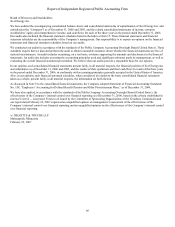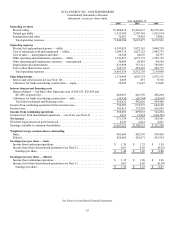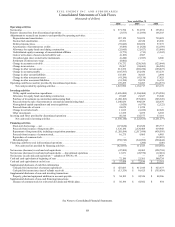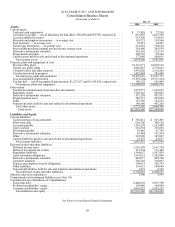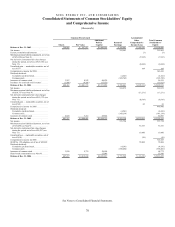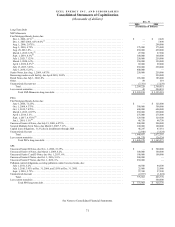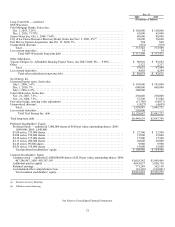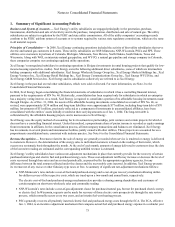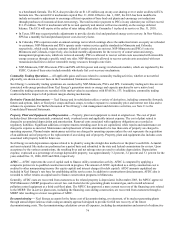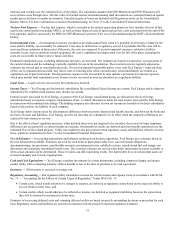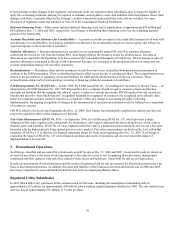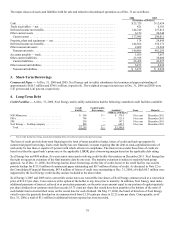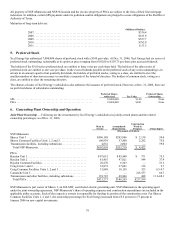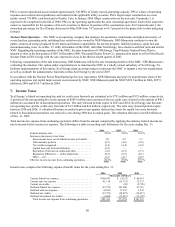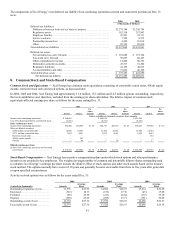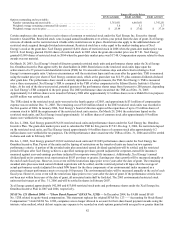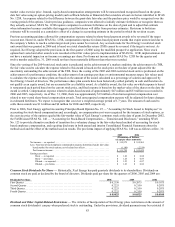Xcel Energy 2006 Annual Report Download - page 83
Download and view the complete annual report
Please find page 83 of the 2006 Xcel Energy annual report below. You can navigate through the pages in the report by either clicking on the pages listed below, or by using the keyword search tool below to find specific information within the annual report.73
Notes to Consolidated Financial Statements
1. Summary of Significant Accounting Policies
Business and System of Accounts — Xcel Energy’s utility subsidiaries are engaged principally in the generation, purchase,
transmission, distribution and sale of electricity and in the purchase, transportation, distribution and sale of natural gas. The utility
subsidiaries are subject to regulation by the FERC and state utility commissions. All of the utility companies’ accounting records
conform to the FERC uniform system of accounts or to systems required by various state regulatory commissions, which are the same
in all material respects.
Principles of Consolidation — In 2006, Xcel Energy continuing operations included the activity of four utility subsidiaries that serve
electric and natural gas customers in 8 states. These utility subsidiaries are NSP-Minnesota, NSP-Wisconsin, PSCo and SPS. These
utilities serve customers in portions of Colorado, Michigan, Minnesota, New Mexico, North Dakota, South Dakota, Texas and
Wisconsin. Along with WGI, an interstate natural gas pipeline, and WYCO, a natural gas pipeline and storage company in Colorado,
these companies comprise our continuing regulated utility operations.
Xcel Energy’s nonregulated subsidiary in continuing operations is Eloigne (investments in rental housing projects that qualify for low-
income housing reported tax credits). Xcel Energy owns the following additional direct subsidiaries, some of which are intermediate
holding companies with additional subsidiaries: Xcel Energy Wholesale Energy Group Inc., Xcel Energy Markets Holdings Inc., Xcel
Energy Ventures Inc., Xcel Energy Retail Holdings Inc., Xcel Energy Communications Group Inc., Xcel Energy WYCO Inc. and
Xcel Energy O&M Services Inc. Xcel Energy and its subsidiaries collectively are referred to as Xcel Energy.
Xcel Energy in the past had several other subsidiaries, which were sold or divested. For more information, see Note 2 to the
Consolidated Financial Statements.
In 2004, Xcel Energy began consolidating the financial statements of subsidiaries in which it has a controlling financial interest,
pursuant to the requirements of FIN No. 46. Historically, consolidation has been required only for subsidiaries in which an enterprise
has a majority voting interest. As a result, Xcel Energy is required to consolidate a portion of its affordable housing investments made
through Eloigne. As of Dec. 31, 2006, the assets of the affordable housing investments consolidated as a result of FIN No. 46, as
revised, were approximately $134 million and long-term liabilities were approximately $77 million, including long-term debt of $70
million. Investments of $51 million, previously reflected as a component of investments in unconsolidated affiliates, have been
consolidated with the entities’ assets initially recorded at their carrying amounts as of Jan. 1, 2004. The long-term debt is
collateralized by the affordable housing projects and is nonrecourse to Xcel Energy.
Xcel Energy uses the equity method of accounting for its investments in partnerships, joint ventures and certain projects for which it
does not have a controlling financial interest. Under this method, a proportionate share of pretax income is recorded as equity earnings
from investments in affiliates. In the consolidation process, all intercompany transactions and balances are eliminated. Xcel Energy
has investments in several plants and transmission facilities jointly owned with other utilities. These projects are accounted for on a
proportionate consolidation basis, consistent with industry practice. See Note 6 to the Consolidated Financial Statements.
Revenue Recognition — Revenues related to the sale of energy are generally recorded when service is rendered or energy is delivered
to customers. However, the determination of the energy sales to individual customers is based on the reading of their meter, which
occurs on a systematic basis throughout the month. At the end of each month, amounts of energy delivered to customers since the date
of the last meter reading are estimated and the corresponding unbilled revenue is estimated.
Xcel Energy’s utility subsidiaries have various rate-adjustment mechanisms in place that currently provide for the recovery of certain
purchased natural gas and electric fuel and purchased energy costs. These cost-adjustment tariffs may increase or decrease the level of
costs recovered through base rates and are revised periodically, as prescribed by the appropriate regulatory agencies, for any
difference between the total amount collected under the clauses and the recoverable costs incurred. In addition, Xcel Energy presents
its revenue net of any excise or other fiduciary-type taxes or fees. A summary of significant rate-adjustment mechanisms follows:
• NSP-Minnesota’s rates include a cost-of-fuel-and-purchased-energy and a cost-of-gas recovery mechanism allowing dollar-
for-dollar recovery of the respective costs, which are trued-up on a two-month and annual basis, respectively.
The electric cost-of-fuel-and-purchased-energy mechanism also provides a sharing among shareholders and customers of
certain margins on short-term wholesale sales and commodity trading.
• NSP-Wisconsin’s rates include a cost-of-gas adjustment clause for purchased natural gas, but not for purchased electric energy
or electric fuel. In Wisconsin, requests can be made for recovery of those electric costs prospectively through the rate review
process, which normally occurs every two years, and an interim fuel-cost hearing process.
• PSCo generally recovers all prudently incurred electric fuel and purchased energy costs through the ECA. The ECA, effective
Jan. 1, 2004, is an incentive adjustment mechanism that compares actual fuel and purchased energy expense in a calendar year





